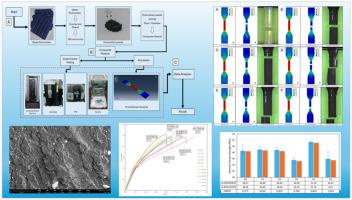Characteristics and evaluation of recycled waste PVCs as a filler in composite structures: Validation through simulation and experimental methods
IF 5.3
Q2 MATERIALS SCIENCE, COMPOSITES
引用次数: 0
Abstract
Solar Cell as a renewable energy utilization in today's era is considered a suitable choice due to encompass sustainability, environmental preservation, and energy processing efficiency. Solar cells have a finite lifespan that need replacement to maintain energy absorption efficiency. Unfortunately, discarded materials are often underutilized or improperly disposed of. In this study, used photovoltaic solar cell materials are explored as reinforcements in composites. The results showed that 4 % cell filler specimen exhibited highest ultimate tensile strength (UTS) with 51.43 MPa. Followed by Compression strength with 35.38 MPa and flexural strength with 45.54 MPa. SEM/EDS analysis of PV filler specimens revealed the dominance of Carbon (C) and Silica (Si) materials, comprising over 60 %. FT-IR analysis indicated varying compound bond intensities affecting polymerization and material strength under applied forces. Simulation results showed a difference of <2 % when compared to experimental testing outcomes. The current study benefited in environmental conservation efforts through waste reduction and the reuse of recycled materials and are listed in several applications such as in wind turbine, structures, lightweight laminates, automotive structures, and sport equipment.

作为复合材料结构填充物的回收废聚氯乙烯的特性和评估:通过模拟和实验方法进行验证
在当今时代,太阳能电池作为一种可再生能源,因其可持续性、环境保护和能源处理效率而被认为是一种合适的选择。太阳能电池的寿命有限,需要更换以保持能量吸收效率。遗憾的是,废弃材料往往没有得到充分利用或处理不当。在这项研究中,探讨了将废旧光伏太阳能电池材料作为复合材料的增强材料。结果表明,4% 电池填料试样的极限拉伸强度(UTS)最高,为 51.43 兆帕。其次是压缩强度(35.38 兆帕)和弯曲强度(45.54 兆帕)。光伏填料试样的 SEM/EDS 分析表明,碳(C)和硅(Si)材料占主导地位,超过 60%。傅立叶变换红外分析表明,不同的化合物键强度会影响聚合和材料在外力作用下的强度。模拟结果显示,与实验测试结果相比,差异为 2%。目前的研究通过减少废物和再利用回收材料,有利于环境保护工作,并被广泛应用于风力涡轮机、结构、轻质层压板、汽车结构和运动器材等领域。
本文章由计算机程序翻译,如有差异,请以英文原文为准。
求助全文
约1分钟内获得全文
求助全文
来源期刊

Composites Part C Open Access
Engineering-Mechanical Engineering
CiteScore
8.60
自引率
2.40%
发文量
96
审稿时长
55 days
 求助内容:
求助内容: 应助结果提醒方式:
应助结果提醒方式:


